- Home
- Kathy Reichs
Bones Are Forever Page 5
Bones Are Forever Read online
Page 5
Yes, the slaughter of innocents outraged him. Women. Children. The elderly. I knew that. But this current moodiness seemed different. More than me. More than dead babies.
Whatever. He’d tell me when he was ready. Or not.
While changing into street clothes, I decided on dinner at home before heading to St. Mary’s.
And remembered.
“Damn.”
I detest grocery shopping. Irrational, but there it is. I’ll make any excuse to avoid the supermarket. Then I pay the price. Like tonight. I hadn’t bought food since arriving in Montreal two days earlier.
As I tossed my soiled scrubs into a biohazard bin, another thought heightened my melancholy.
When I’d departed Charlotte, Birdie had been recovering from a urinary tract infection. Knowing he hated air travel, and feeling the trip might compromise his wee bladder, I’d left him in Dixie. The cat offered no protest.
Frozen dinner. Alone.
As I walked up the corridor, my spirits went subterranean. I was considering take-out options when, through the window, I noticed a figure in my lab.
I froze. Then recognition.
Ryan. Jabbing digits on a cell phone.
At six-thirty? What the hell?
Ryan turned when I pushed through the door. Before I could speak, he cut me off. “We got her.”
“Amy Roberts et cet?”
Ryan nodded.
“And?”
“You won’t believe it.”
“HER REAL NAME IS ANNALIESE RUBEN. SHE WAS POPPED TWICE for prostitution, once in 2005, again in 2008. Both arrests were in Edmonton. First time she got probation. Second time she was a no-show for the court date.”
Ryan handed me three printouts.
The first was a response to the fingerprint search. Skipping the part about points of correspondence, I skimmed the physical descriptors. Annaliese Ruben had black hair, brown eyes, stood five feet tall, and weighed 195 pounds.
The second printout was a report on Ruben’s criminal history. The third provided her most recent mug shot, obtained using the fingerprint system number. Ruben’s thumbnail showed a woman with a moon face and dark tangled hair that badly needed grooming.
I handed back the sheets. “Might have an overactive thyroid.”
“Yeah?”
“The bulging eyeballs. Or it could be the lighting. Mug shots don’t bring out the best in folks.”
“Edmonton PD says the address Ruben provided after the second collar turned out to be an abandoned warehouse. They’ve had no contact with her since ’08, know nothing about her current whereabouts.”
Ryan pocketed his iPhone and hip-planted his hands. There was stiffness in his movements, tension in his shoulders and jaw. Familiar signs. This case had gotten to him.
But there was more. A hardness in Ryan’s eyes that I hadn’t seen before.
I wanted to ask if there was something wrong, to say I was here if he wanted to talk. I didn’t. Just waited.
“Are you familiar with Project KARE?” Ryan spelled out the acronym.
“Isn’t it an RCMP task force created to investigate deaths and disappearances of women in and around Edmonton? I understand there have been quite a few.”
“That’s an understatement. But yeah, essentially, you’re right. Their mandate is to collar the scumbags responsible for HRMP murders.”
“High-risk missing persons.”
“Yes.” Ryan was keeping his voice carefully modulated.
“Meaning those involved in prostitution and drugs.” I sensed where this was going.
“Yes.”
“Annaliese Ruben is on the Project KARE list,” I guessed.
“Since 2009.”
“Who reported her missing?”
“Another prossie.”
That surprised me. “Sex-trade workers usually steer clear of the cops.”
“No shit. But the hookers in Edmonton are totally freaked.”
“Wasn’t someone arrested for those killings?”
“Thomas Svekla. A real piece of work. Charged with two murders, convicted of one.” Ryan shook his head in disgust. “He’d stuffed his victim into a hockey bag and hauled her from High Level to Fort Saskatchewan.”
“At least they got him.”
“Word is there’s more than one perp responsible.”
“So a predator may still be out there.”
“Yeah. Predator or predators.”
Ryan’s eyes looked dark and troubled. And too intensely blue to be real.
“But if Annaliese Ruben gave birth in Saint-Hyacinthe last Sunday, obviously she’s alive,” I said.
“And murdering babies.”
“We don’t know that.”
“Who but the mother could kill three different newborns at three times? And why’d she go rabbit?”
“What’s your next move?”
“Run the mug shot past Ralph Trees. See if Annaliese Ruben is Amy Roberts/Alma Rogers/Alva Rodriguez.”
“Then?”
“Then find her ass and haul it to the bag.”
* * *
I went with pad thai from the Bangkok at Le Faubourg on rue Sainte-Catherine. The line was short and I was running late.
St. Mary’s Hospital started life in 1924 as a forty-five-bed affair in Shaughnessy House, now the Canadian Centre for Architecture. A decade later, operations moved from there to avenue Lacombe in the Côte-des-Neiges neighborhood, just over the mountain from centre-ville. Today the old girl is a multipavilion institution offering 316 patient beds and a staff active in teaching and research.
Le stationnement was a replay of twelve hours earlier. At eight-fifty a car finally pulled out on rue Jean-Brillant. I fired into the spot, grabbed my things, and bolted.
The area was surprisingly active for nine P.M. on a Tuesday. Cars filled the streets, and pedestrians chugged along the walks—shoppers clutching plastic grocery bags; hospital visitors, empty-handed, probably heading home; backpacked students from Université de Montréal or Collège Notre-Dame.
St. Mary’s is not one of Quebec’s architectural gems. The main building is a multilevel concrete and redbrick box with a castlelike tower jutting up at its center. I beelined to the entrance and pushed through the glass doors.
The lobby was mostly deserted. An old man sat with legs outstretched, chin on chest, snoring softly. A woman pushed a stroller in endless circles, looking exhausted. Two orderlies discussed a physician’s printed order, or a menu, or a recipe for lentil soup.
LaManche stood on the lobby’s far side by a bank of elevators. Pomier was beside him, string-handled bags hanging from his curled fingers. With them was a tall man in wire-rimmed glasses whom I assumed was Dr. Leclerc.
When I joined the trio, Leclerc spread his feet and crossed his arms in a posture more characteristic of a bouncer than a physician.
“How many more?” Leclerc’s French hinted at stone gargoyles and arrondissements. I guessed he wasn’t from around these parts.
“We are all here,” LaManche said.
“This must be handled with the greatest of delicacy.”
“Of course.”
Leclerc shook his head, kept shaking it while repeatedly punching the button for an elevator. When the car came, I got in first and moved to the back. As we ascended, I scoped out our host.
Leclerc’s thin brown hair was parted with military precision. His lab coat was eye-blistering white, his khakis creased sharp enough to draw blood. I guessed flexibility was not the guy’s strong suit.
When the doors opened, Leclerc led us down a shiny tile corridor to an X-ray room reminiscent of the one at the LSJML. One difference: no changing rooms at Wilfrid-Derome. Our patients arrived and departed naked.
Through a window, I could see a woman seated beside a machine that looked like a large square donut with a narrow cot projecting from the hole. The woman’s hair was black, her skin the color of walnuts. From her scrubs, I assumed she was a radiology nurse or technician.
br /> “Mrs. Tong will assist you. I have explained”—Leclerc’s lips twisted to one side as he sought the right word—“the situation.”
When Leclerc rapped on the glass, Mrs. Tong looked up. As she rose, set down her magazine, and crossed to the door separating us from the scanning room, Leclerc continued talking.
“I have authorized Mrs. Tong to do full-body MSCTs on both subjects. Each axial scan will be performed with sixteen-by-three-quarter-millimeter collimation. The apparatus is a Sensation 16 unit. I have instructed Mrs. Tong to use two filters, one for bone and one for soft-tissue analysis.”
Leclerc’s delivery was so stiff, he sounded like a recording. “Mrs. Tong has agreed to remain beyond her normal shift. Please do not delay her any longer than necessary. Please follow her directives.”
“Oh, goodness me. I’m happy to help.” Mrs. Tong smiled warmly. “Got no kids to hurry home to. No church tonight. Fact is—”
“Thank you.”
The woman’s smile faded under her boss’s flinty glance.
Leclerc turned to LaManche. “Who will handle the subjects?”
LaManche’s gaze rolled to me. I nodded.
“I think this guy slept with a broom up his ass,” Pomier said under his breath as I took the bags from him.
Three pairs of eyes followed Mrs. Tong and me into the scanning room. She started talking as soon as the door clicked shut.
“I call her Felix the Cat.” She flapped a hand at the scanner. “You know, for CAT scan. That’s what they used to be called. It’s silly, I know. But a lot of patients are nervous as jackrabbits when they get shoved into a big whirring box. Naming the thing after a cartoon character helps ease the jitters.”
“Mrs. Tong—”
“What are we, dining with the queen here? Call me Opaline. You know how Felix works?” As she spoke, she adjusted dials and flipped switches.
“I understand—”
“No magic. The old boy uses a computer and a rotating X-ray device to create cross-sectional images of organs and body parts. I’m talking slices with detail that’ll blow your socks off.”
It was clear that Opaline Tong loved to talk. Or was nervous as hell around dead babies. Her eyes avoided mine as I opened the first tub.
“The T in ‘CT’ stands for ‘tomography.’ You know what that means?”
“Imaging by sections using penetrating waves.” I placed the tiny mummy designated LSJML-49277 on the patient couch, face-up, and secured it by buckling the straps.
“OK, then. You’re a smart one.”
Opaline pushed a button to move the couch up, then forward and backward inside the hole. When the baby was properly positioned, she stepped sideways and slapped the donut.
“The scanner itself is this circular rotating frame. It’s got an X-ray tube on one side and a detector on the other that looks kind of like a banana. The rotating frame will spin the X-ray tube and detector around our poor little fella here, creating a fan-shaped beam of X-rays. The detector will take snapshots called profiles. Typically, about a thousand each time around. So with each complete rotation, we’ll get one cross-sectional slice.”
Opaline’s tone had become a little less kindergarten-teacher sweet.
“The computer will use digital geometry processing to generate three-dimensional images of the inside of the body from the series of two-dimensional images taken around our single axis of rotation. Get it?”
“I do. Thank you.”
“You ready?”
I nodded.
“Let’s do it.”
* * *
Forty-three minutes later, we were all in the anteroom with Mrs. Tong seated at the workstation, the rest of us bunched around her. While entering instructions, she’d explained how the data produced by the scanner would be manipulated through a process known as windowing to demonstrate various bodily structures based on their ability to block the X-ray beam. She said that although images generated were historically in the axial or transverse plane, orthogonal to the long axis of the body, modern scanners now allowed data to be reformatted in various planes or even as volumetric—three-dimensional—representations.
First we’d viewed two-dimensional images produced, according to Mrs. Tong, by MPR, or multiplanar reconstruction. Slice by slice, we’d moved from the window-seat baby’s head to its toes, interpreting pictures that resembled abstracts by Miró.
We’d noted that the skull was deformed due to collapse of both parietal bones. We’d seen that the auditory canals were well defined, that the tiny ossicles—the maleus, incus, and stapes—were present in the middle ear. Leclerc had pointed out the cochlea and vestibule of the inner ear, the labyrinthine segment of the facial nerve canal, the pyramidal process, and other anatomical features.
I’d measured the pars squama and the pars basilaris of the occipital bone and the lengths of the femoral and tibial shafts.
We’d all agreed. The fetus was full-term.
“Switch to three-dimensional?” Mrs. Tong asked.
“Yes,” Leclerc said.
“These images will be produced using the volume-rendering technique and maximum-intensity mode,” Mrs. Tong said.
No abstracts now. The baby appeared in detailed shades of gray and white, angled down, tiny limbs V’ed inward like two sets of wings.
Leclerc used a finger to point out the obvious. “Remnants of the cerebral hemispheres, cerebellum, pons, medulla oblongata, spinal cord.” His finger moved from the skull to the thorax. “Esophagus, trachea, lungs. This is the heart, though I can’t make out the separate cardiac chambers.” He indicated the abdomen. “There’s the stomach, the liver. The rest of the organs are unrecognizable.”
“Is that a penis?” Pomier’s voice sounded husky.
“It is.”
“I see no skeletal malformations or trauma,” I said.
Leclerc and LaManche agreed, then exchanged comments about a few anatomical landmarks.
I didn’t really hear. My attention had shifted to an area of radio opacity in the trachea, partly obscured by superimposition of the tiny jaw.
“What the flip is that?”
LAMANCHE NODDED AS THOUGH I’D ANSWERED A QUESTION, not asked one. Obviously, he saw it, too.
“I noticed that earlier, thought the cloudiness was an artifact,” Leclerc said. “Now I’m not so sure.”
“Is there any way to visualize the area more clearly?” I asked.
Mrs. Tong went back to 2-D, and we viewed the infant’s neck in slices. It didn’t help much. The radio opacity appeared centered in the trachea or esophagus. Beyond that, we could make out little detail.
“Perhaps dust or sediment filtered in through the mouth following decomposition,” LaManche suggested.
“Perhaps.” I didn’t believe it. The white glow was intense, suggesting solidity.
For a full minute we all stared at the monitor. Then I made a decision. “May I borrow a scalpel and forceps?”
“Of course.” Leclerc hurried off, reappeared in moments, and handed the instruments to me.
As the others watched, I returned to the scanner and unpocketed and snapped on gloves.
Forgive me, little one.
While steadying the baby with my left hand, I drew the scalpel blade across the shriveled little throat with my right.
The papery tissue split with a soft pop. Laying the scalpel aside, I picked up and inserted the forceps. Three quarters of an inch down, they met an obstruction.
I separated the tines, closed them, and gently tugged. The mass didn’t budge.
Barely breathing, I opened the tips wider, wiggled them deeper, and pulled again.
The obstructing object yielded its grip on the trachea and slid upward with a dry scratching sound. Advancing by millimeters, I teased it through the incision and dropped it onto my palm.
Dingy white. Gauzy and crinkled.
I poked at one edge with the tweezers. A filmy layer lifted, revealing a dotted perforation.
Swee
t mother of God!
A cerebral flare exploded, an image too horrible to contemplate.
I had to stand a moment, fighting the ice in my chest, the burning behind my lids.
When I’d regained my composure, I looked again at the baby.
I am so sorry. So very, very sorry.
One deep breath, then I rejoined those waiting behind the glass.
Wordlessly, I uncurled my fingers, revealing the horrific thing in my hand. Everyone stared, puzzled.
LaManche spoke first. “Wadded toilet tissue.”
I could only nod.
“Forced down the child’s throat to stop his breathing.”
“Or crying.”
That was it for Mrs. Tong. She began to weep. Not big blubbery sobs but hiccupy whimpers. As the others stood in awkward silence, I placed a hand on her shoulder.
She turned her head and gazed up at me over one shoulder. “Someone killed this little angel on purpose?”
My look was answer enough.
In a low and very even voice, I said to LaManche, “Detective Ryan will want to know.”
“Yes. Please transmit this information to him.”
As I hurried through the door, Leclerc asked Mrs. Tong if she would like to go home.
“Not on your life.”
The corridor was deserted. Ignoring the hospital’s no-cell-phone policy, I scrolled to and tapped Ryan’s private number on my iPhone. His mobile rang, then rolled to voice mail.
Damn.
I left a message: “Call me back. Important.”
I looked at my watch. Eleven-ten.
I walked to the end of the hall. The place was a ghost town.
I walked back toward X-ray. Checked the time again.
Eleven-fourteen.
I paced. Eleven-twenty-two.
Where the hell was he?
I was about to give up when Ryan finally called. I launched right in. “At least two of the babies were full-term. We’ll know about the third one shortly.”
“Any medical problems?”
“No. The window-seat baby is a boy.” I told him about the bunched-up toilet paper.
For a long moment only background noise buzzed across the line. Voices. Clinking glassware.
“That it?” Clipped. Ryan was fighting to check his emotions, as I had.

 Two Nights
Two Nights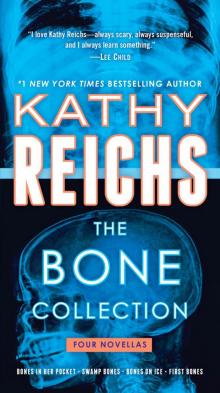 The Bone Collection: Four Novellas
The Bone Collection: Four Novellas Fatal Voyage
Fatal Voyage 206 Bones
206 Bones Bones to Ashes
Bones to Ashes Terminal
Terminal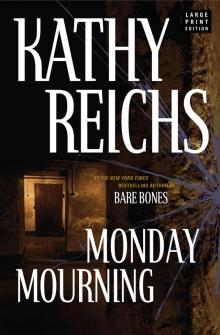 Monday Mourning
Monday Mourning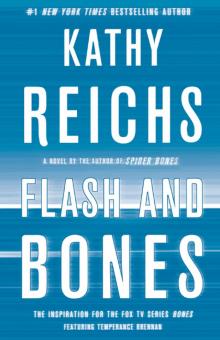 Flash and Bones
Flash and Bones Cross Bones
Cross Bones Devil Bones
Devil Bones Break No Bones
Break No Bones Swamp Bones
Swamp Bones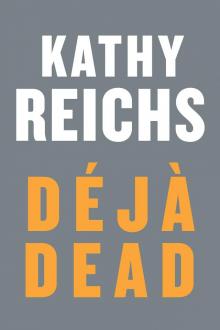 Déjà Dead
Déjà Dead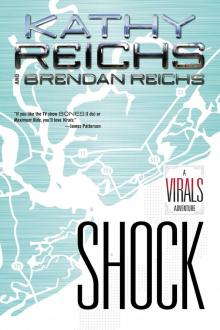 Shock
Shock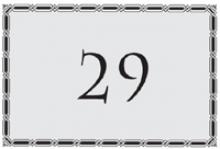 Spider Bones
Spider Bones Death Du Jour
Death Du Jour Grave Secrets
Grave Secrets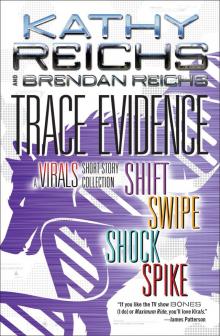 Trace Evidence: A Virals Short Story Collection
Trace Evidence: A Virals Short Story Collection Bones on Ice
Bones on Ice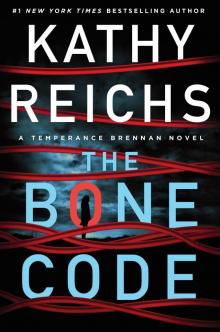 The Bone Code
The Bone Code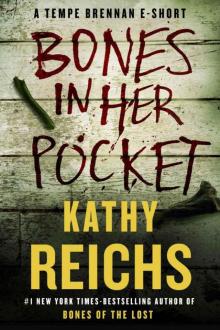 Bones in Her Pocket
Bones in Her Pocket Seizure:
Seizure: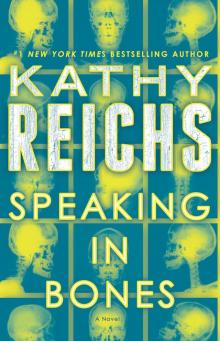 Speaking in Bones
Speaking in Bones Deadly Decisions
Deadly Decisions Spike
Spike Bones Never Lie
Bones Never Lie Bones of the Lost
Bones of the Lost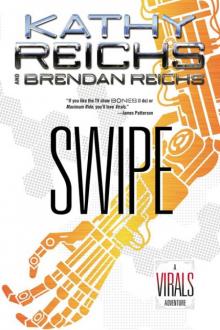 Virals 03.5 - Swipe
Virals 03.5 - Swipe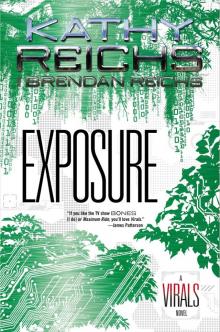 Exposure
Exposure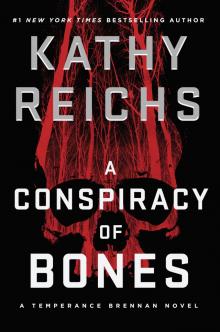 A Conspiracy of Bones
A Conspiracy of Bones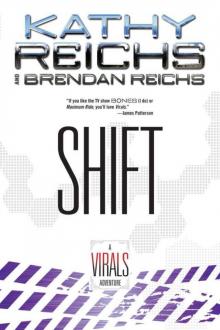 Shift (tory brennan)
Shift (tory brennan) Bones of the Lost: A Temperance Brennan Novel tb-16
Bones of the Lost: A Temperance Brennan Novel tb-16 Virals tb-1
Virals tb-1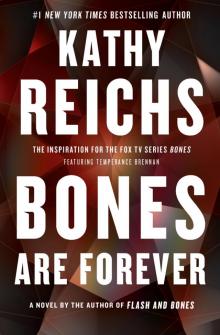 Bones Are Forever tb-15
Bones Are Forever tb-15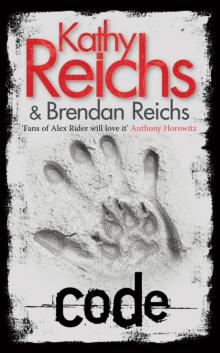 Code tb-3
Code tb-3 Seizure tb-2
Seizure tb-2 Deadly Descisions
Deadly Descisions Spider Bones: A Novel
Spider Bones: A Novel